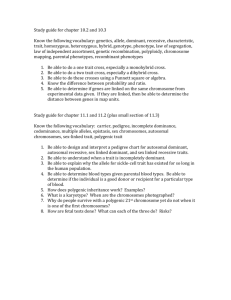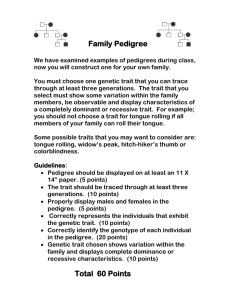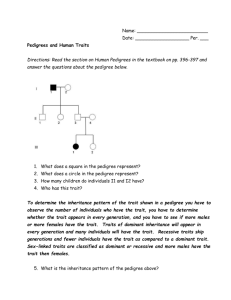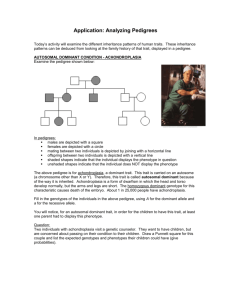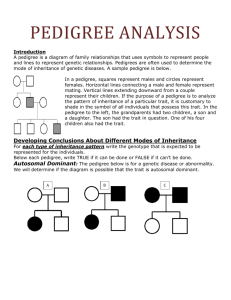We Are Family! Introduction to Pedigree Genetics
advertisement
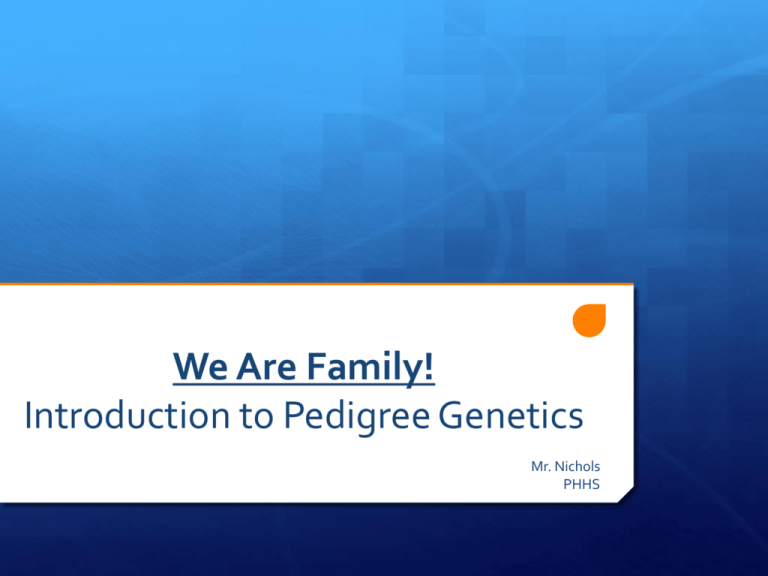
We Are Family! Introduction to Pedigree Genetics Mr. Nichols PHHS Cartoon of the Day: Get Punked! Objectives The Student will be able to: 1.) Finish the 2 trait Punnet square practice problems. 2.) Sketch and describe the basic anatomy of a family pedigree. 3.) Use the information from a pedigree to infer genotypes and answer application questions. Are you ready for some Pedigrees?!?! Before we move on any questions regarding Punnett Squares? What are Pedigrees? A pedigree is a diagram of family relationships that uses symbols to represent people and lines to represent genetic relationships. Pedigrees are often used to determine the mode of inheritance (dominant, recessive, etc.) of genetic diseases. Autosomal: Refers to chromosomes that are NOT sex chromosomes (xx or xy). Anatomy of a Pedigree Circle= Female Square= Male A line connecting a square and a circle implies they “mated.” Probably in the early afternoon. If a circle or square is darkened, that means has a particular trait or suffers from a disease/disorder. Different Modes of Inheritance: 1.) Autosomal Dominant Diseases or traits that exhibit an Autosomal Dominant inheritance pattern follow the following rule: A = the trait (a genetic disease or abnormality, dominant) a = normal (recessive) Examples of autosomal dominant disorders: Achondroplasia, pseudoachondroplasia, the multiple epiphyseal dysplasias, chondrodysplasias, osteogenesis imperfecta, Marfan syndrome, polydactyly, hereditary motor sensory neuropathies I and II (Charcot-Marie-Tooth disease), myotonic dystrophy, and neurofibromatosis. Are these both examples of Autosomal Dominant Pedigrees? A Explain your answer! B What are the genotypes in pedigree B? Quick Review Question! You know you love it! What can you conclude from these two examples about the parents of a person that has a dominant characteristic? A.)If a person has a dominant trait, the parents will not have the trait. B.)If a person has a dominant trait, the parents might have the trait or they might not have it. C.) If a person has a dominant trait, at least one of the parents will have the trait. D.)If a person has a dominant trait, both of the parents will have the trait. Another Example: AwwYea!! What are the genotypes in this pedigree? Quick Review Questions: The Adventure Continues! 1.) Is it possible that this pedigree is for an autosomal dominant trait? 2.) Can two individuals that have an autosomal dominant trait have unaffected children? A.)If two individuals have a dominant trait, none of their offspring will have the trait. B.)If two individuals have a dominant trait, their offspring might or might not have the trait. C.)If two individuals have a dominant trait, their offspring will have the trait. We Are Family: Day 2 Introduction to Pedigree Genetics Mr. Nichols PHHS Cartoon of the Day: Bear Season! Different Modes of Inheritance: 2.) Autosomal Recessive Diseases or traits that follow Autosomal Recessive inheritance patterns: A = normal a = the trait (a genetic disease or abnormality) Examples of Autosomal Recessive diseases: Cystic fibrosis, sickle cell anemia (We will study this very soon), and Tay Sachs disease. Guess what: More Pedigrees! Assuming that the trait is recessive, write the genotype of each individual next to the symbol. Is this an example of an Autosomal Recessive Pedigree? What About this one? Assuming the disorder is recessive, is this an example of an Autosomal Recessive pedigree? Write in the Genotypes for each individual. Quick Review Question: Great things come in 3’s 1.) If a trait is autosomal recessive, what can you conclude about the children if both parents are affected? A.) If both parents are affected, none of the children will be affected. B.)If both parents are affected, the children might or might not be affected. C.)If both parents are affected, all of the children will be affected. Hmm, what about this one? Is it possible that this pedigree is for an autosomal recessive trait? What are the Genotypes for these individuals? Quick Review Question: If a trait is autosomal recessive, what can you conclude about the children of two parents that are not affected? A.) If two parents have a dominant trait, the children will not have the trait. B.) If two parents have a dominant trait, the children might or might not have the trait. C.) If two parents have a dominant trait, the children will have the trait. Challenge Question 1 Assign Genotypes as usual. Can this pedigree possible represent an Autosomal Recessive disease? What does this pedigree infer about recessive traits? Different Modes of Inheritance: 3.) X-Linked Recessive The sex of an individual has been linked to certain disorders, we’ll finish by examining these pedigrees. New Nomenclature XA = normal Xa = the trait (a genetic disease or abnormality) Y = Y chromosome (males only) Examples for a Female: XAXa, XAXA, XaXa What would the male sex genotype look like? Examples for Males: XAY, XaY Let’s Practice Assign the genotypes (Use X and Y’s now). Is it possible that the pedigree above is for an X-linked recessive trait? Keep Going, almost there! Assign the genotypes (Use X and Y’s now). Is it possible that these pedigrees represent an X-linked recessive trait? Last Quick Review Questions! What can you conclude about the children of mothers affected with an X-linked recessive trait: If the mother has an X-linked recessive trait, the children will not have the trait. A. )If the mother has an X-linked recessive trait, the children might or might not have the trait. B.) If the mother has an X-linked recessive trait, all of the children will have the trait. C.) If the mother has an X-linked recessive trait, females will have the trait but males will only have the trait if their father also has the trait. D.) If the mother has an X-linked recessive trait, males will have the trait, but females will only have the trait if their father also has the trait. Last Quick Review Questions! A New Hope! What can you conclude about the father of an affected female? A.)The father of an affected female will not be affected. B.) The father of an affected female might or might not be affected. C.)The father of an affected female will be affected. Why is this so? Let’s Explore that tomorrow! Different Modes of Inheritance: 4.) X-Linked Dominant XA =the trait (a genetic disease or abnormality) Xa = Normal Y = Y chromosome (males only) Common X-Linked Dominant Diseases: Few and Rare! Vitamin D resistant rickets Rett's syndrome Fragile X syndrome Getting the hang of this yet? Let’s see! Our First Genetic Case Study! When Queen Victoria of England was seventeen, she met one of her many cousins, Prince Albert of Saxe-Coburg. She fell deeply in love with him, and several years later, when they were both twenty years old, Victoria proposed to Albert. They were married on February 11, 1840; both were deliriously happy, and Victoria made Albert Prince Consort, giving him an equal say in the running of the country. What neither of them knew at the time was that Victoria was carrying the gene for hemophilia. Your Mission! You are a genetic detective tasked with figuring out what type of inheritance pattern this disease is following in Queen Victoria’s family pedigree. You’ve conducted your preliminary research and constructed a rough pedigree of the family history. You’ve also concluded that the disease is not autosomal. Homework! Create a simple Pedigree of your own family! Figure out whether a trait (eye color, hair color, a disease) has an autosomal dominant or autosomal recessive behavior. 2 Generations are required but 3 would be best. Pedigree Practice Problem Sheet (Both) All of this is due Friday!!!! Example


